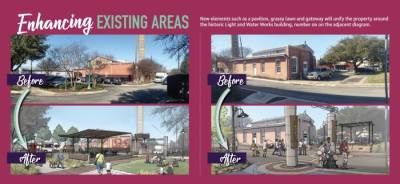Plans for the new City Center are underway. The unification project overseen by the city aims to encompass several blocks, according to Georgetown Facilities Director Eric Johnson. The cohesive space would form a rectangle between West Street to Rock Street and between Eighth Street to Ninth Street.
Chamber of Commerce President Jim Johnson said the city’s continued improvements and enhancements to downtown show a plan that provides additional beautification to the downtown area.
“Additionally, these projects are destination-centered areas, which ideally will offer opportunities for consumers to visit and shop with our businesses in this area and lead to their economic success,” he said.
City Council approved the project’s first steps at the end of May—two items totaling $55,760.
The first is for overall site design. Covey Landscape Architects of Georgetown will include details for “special zones,” Johnson said, to include a library outdoor play area, an alleyway gateway, an alleyway water feature, and an event lawn and stage for small events. The firm will also provide probable costs and a phasing diagram for implementing the project.
The second item approved by council was for Phase 1, which will begin work on what the city refers to as Site One, Site Two A and Site Two B.
Site One involves fixing up the area encompassing the historic Shotgun House behind City Hall. Landscaping will be elevated, and a kiosk providing more information about the house and historic neighborhood will be installed.
Site Two A and B are across the street from each other: Two A is next to City Hall, and Two B is currently a blue annex building that will be taken down. The new design will include a demolition plan for the annex building, a schematic design that will ensure cohesiveness between both lots, and site design and construction documents for Two B.
The project meets one of the city’s official visions and strategies, to “become a destination for unique experiences,” Library Director Eric Lashley said. It also captures almost everything on the downtown master plan, Chapter 7: Parks, Open Space, and Public Art.
The list includes incorporating large plazas for organized events, play space for children, passive green space to serve nearby residents, small outdoor space for modest assemblies, performance space for outdoor concerts and other cultural events, farmers markets and public art.
“The project provides many places for people to meet and have small festivals [when it is safe to do so again],” Lashley said.
The unapproved, proposed 2020-21 budget is expected to contain money to do Phase 1 and the master plan in 2021, Johnson said. Budget permitting, other phases of the project would be completed over the next five years. The exact cost cannot be determined until the design work is done.
Funds for the design are coming out of the fiscal year 2019-20 Downtown Tax Increment Reinvestment Zone, commonly referred to as a TIRZ. The zone is established by City Council and captures the projected increase in tax revenue created by development within a defined area. It then reinvests those funds into public improvement and development projects that enhance that particular area.
City Manager David Morgan said a broad range of projects are eligible for TIRZ funds.
Permitted uses include economic development-related projects, downtown landscaping and public art—all of which will be incorporated into City Center.
Lashley said some initial steps have already been completed: The new parking lot across the street from the library replaced Williamson County buildings, and the Williamson County Farmers Market relocated to that space from its current location at the Monument Cafe parking lot.
Resident Shawn Bichsel said art on sidewalks and open public space is a wonderful thing and necessary for true growth and advancing responsible development.
“Expanding the reach of downtown from beyond the Square is the only thing that will save downtown from itself,” he said.
Resident Trisha Reid Tallman said a development like City Center is needed.
“The area around City Hall, the library, and the historic Light and Waterworks building would give the city another great venue,” she said. “This would shift some events from the Square and give visitors other areas in downtown to visit and other businesses to support. I think this can be a space for more art to be displayed—statues, murals, even temporary artwork displays—as well as a venue for smaller festivals and events.”
She said she believes the project will enhance what Georgetown already has and expand people’s perception of what downtown offers.






